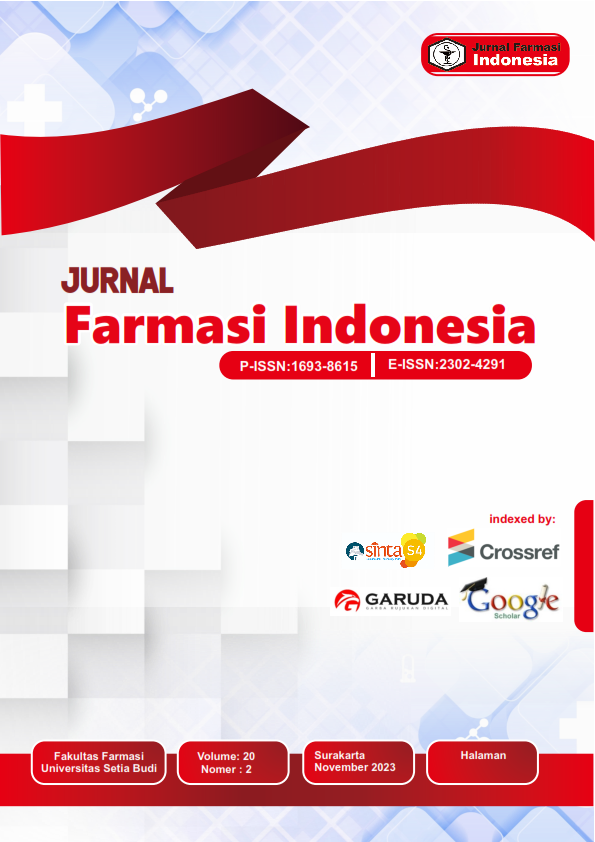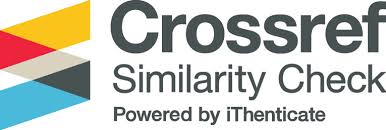Molecular Docking of Andrographis paniculata Bioactive Compounds as Antimalarial Candidates
Abstract
Efforts to eradicate malaria have been severely hampered by the growing resistance of Plasmodium falciparum to currently available antimalarial drugs. Therefore, efforts should be made to find and develop new effective antimalarial drugs for the treatment of malaria. One of the plants reported to have antimalarial activity is sambiloto. This study aims to carry out molecular docking of the bioactive compounds contained in sambiloto to obtain potential compounds that have antimalarial activity.
In this study, 18 bioactive compounds of sambiloto were docked to 3 target proteins involved in the malaria pathway, namely P. falciparum Plasmepsin II (PDB: 1LEE), PfENR (PDB: 1NHG), and PfDHFR-TS (PDB: 7F3Z) using Autodock 4.0. Based on the docking results, the bioactive compounds with the best activity were analyzed using SwissADME webtool for their pharmacokinetic parameters and drug-likeness.
The results showed that the bioactive compound with the best activity against the molecular targets involved in malaria was bisandrographolide C, andrographiside, ninandrographolide, 14-acetylandrographolide, daucosterol, andrographic acid and neoandrographolide. These compounds have the lowest binding energy and interact with important amino acid residues present in the target protein. The bioactive compounds contained in sambiloto have the potential to become candidates for antimalarial drugs and have the opportunity to become oral drugs based on Lipinski’s filter except for andrographiside.
References
[2]. Kombonglangi, R. S. 2015. Manajemen terapi malaria falciparum yang resisten terhadap klorokuin. Journal Majority 4(6): 27-30.
[3]. Anindita, V., Mutiara, H., Mutiara, U. G. 2017. Mutasi gen kelch 13 dan resistensi Plasmodium falciparum terhadap obat antimalaria golongan artemisinin. Medula 7(5): 149-153.
[4]. Latifah, N., Subarnas, A., Chaerunisaa, A. Y. 2020. Antimalaria medicine and its mechanism: a review. Majalah Farmasetika 5(1): 39-48. http://dx.doi.org/10.24198/mfarmasetika.v5i1.25927
[5]. Anas, Y., Ratnani, R. D., Kurniasari, L., Hartati, I. 2020. Aktivitas antiplasmodium ekstrak hidrotropi daun sambiloto (Andrographis paniculata Ness.) secara in vitro pada Plasmodium falciparum strain G-2300 resisten kloroquin. Jurnal Ilmu Farmasi dan Farmasi Klinik 17(1): 1-7. http://dx.doi.org/10.31942/jiffk.v17i01.3479
[6]. Resi, E. K. 2014. Effect of antimalaria herbal sambiloto (Andrographis paniculata Nees.) on morphology changes of development and parasite Plasmodium falciparum. Jurnal Info Kesehatan 12(1): 661-671.
[7]. Niranjan, A., Tewari, S. K., Lehri, A. 2010. Biological activities of Kalmegh (Andrographis paniculata Nees) and its active principles-a review. Indian Journal of Natural Products and Resources 1(2): 125-135.
[8]. Asojo, O. A., et al. 2022. Structure of Ser205 mutant plasmepsin II from Plasmodium falciparum at 1.8 Å in complex with the inhibitors rs367 and rs370. Acta Cristallographica Section D Biological Cristallography 58: 2001-2008. https://doi.org/10.1107/s0907444902014695
[9]. Perozzo, R., et al. 2002. Structural elucidation of the specificity of the antibacterial agent triclosan for malarial enoyl acyl carrier protein reductase. The Journal of Biological Chemistry 277(15): 13106-13114. https://doi.org/10.1074/jbc.M112000200
[10]. Chaianantakul, N., et al. 2020. Antimalarial effect of cell penetrating peptides derived from the junctional region of Plasmodium falciparum dihydrofolate reductase-thymidylate synthase. Peptides 131: 1-8. https://doi.org/10.1016/j.peptides.2020.170372
[11]. Kupka, R. 2016. The role of folate in malaria-implication for home fortification programmes among children aged 6-59 months. Maternal & Child Nutrition 11(Suppl 4): 1-15. https://doi.org/10.1111.mcn.12102
[12]. Meng XY, Zhang HX, Mezei M, Cui M. 2011. Molecular docking: a powerful approach for structure-based drug discovery. Current Computer-Aided Drug Design 7: 146-157. https://doi.org/10.2174/157340911795677602
[13]. Guedes IA, Magalhaes CS de, Dardenne LE. 2014. Receptor-ligand molecular docking. Biophysical Review 6: 75-87. https://doi.org/10.1007/s12551-013-0130-2
[14]. Bahi, R, R, R., Herowati, R., Harmastuti, N. 2020. Studi biokemoinformatika kandungan kimia daun sambiloto (Andrographis paniculata (Burm.f.) Nees) sebagai antihiperglikemia serta prediksi parameter farmakokinetik dan toksisitas. Pharmacy: Jurnal Farmasi Indonesia 17(2): 466-477. https://doi.org/10.30595/pharmacy.v17i2.8944
[15]. Singh, I, V., and Mishra, S. 2018. Molecular docking analysis of pyrimethamine derivatives with Plasmodium falciparum dihydrofolate reductase. Bioinformation 14(5): 232-235. https://doi.org/10.6026/97320630014232
[16]. Daina, A., Michielin, O., Zoete, V. 2017. SwissADME: a free web tool to evaluate pharmacokinetics, drug-likeness and medicinal chemistry friendliness of small molecules. Scientific Reports 7:1-13. https://doi.org/10.1038/srep42717
[17]. Chakraborty, P., Ramakrishnan, M. 2016. Role of P-glycoprotein in chemotherapeutic drug resistance and mechanisms of pump deactivation to overcome MDR in cancer cells–a critical review. Frontiers in Biomedical Sciences 1(2):31-38.
[18]. Lipinski, C. A., Lombardo, F., Dominy, B. W., Feeney, F. J. 2001. Experimental and computational approaches to estimate solubility and permeability in drug discovery and development settings. Advanced Drug Delivery Reviews 23: 3-25. https://doi.org/10.1016/S0169-409X(00)00129-0













